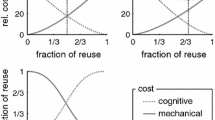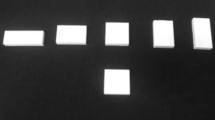Abstract
In a prior study (Schütz et al. in Exp Brain Res 2016. doi:10.1007/s00221-016-4608-6), we demonstrated that the cognitive cost of motor planning did not differ in a vertical pointing and grasping task. It was unclear whether the similar cost implied that both tasks required the same number of independent degrees of freedom (IDOFs) or that the number of IDOFs did not affect motor planning. To differentiate between both cases, a reanalysis of the prior data was conducted. The number of IDOFs in the pointing and grasping tasks was computed by factor analysis. In both tasks, two IDOFs were used, which was the minimum number required for position control. This indicates that hand alignment in the grasping task did not require an additional IDOF. No conclusions regarding the link between the cognitive cost of motor planning and the number of IDOFs could be drawn. A subset of task-critical joint angles was not affected by motor hysteresis. This indicates that a joint’s susceptibility to motor hysteresis depends on its relevance to the task goal. In task-critical joints, planning cost minimization by motor plan reuse is suppressed in favor of the task goal.






Similar content being viewed by others
Notes
Best separation for the main effect of 'drawer' could also have been used as the optimization criterion. Rotations for this criterion were similar: 109.11° ('sequence') versus 104.98° ('drawer') for pointing and 90.30° ('sequence') versus 89.54° ('drawer') for grasping. As all joint angles were equally affected by drawer height, an elimination of the main effect of 'drawer' from one of the factors was impossible. Therefore, the main effect of 'sequence' was used as the optimization criterion.
References
Bernstein NA (1967) The co-ordination and regulation of movements. Pergamon Press Ltd., Oxford
Diedrichsen J, White O, Newman D, Lally N (2010) Use-dependent and error-based learning of motor behaviors. J Neurosci 30:5159–5166
Jackson DA (1993) Stopping rules in principal components analysis: a comparison of heuristic and statistical approaches. Ecology 74:2204–2214
Jax SA, Rosenbaum DA (2007) Hand path priming in manual obstacle avoidance: evidence that the dorsal stream does not only control visually guided actions in real time. J Exp Psychol Hum Percept Perform 33:425–441
Jax SA, Rosenbaum DA (2009) Hand path priming in manual obstacle avoidance: rapid decay of dorsal stream information. Neuropsychologia 47:1573–1577
Kelso JAS, Buchanan JJ, Murata T (1994) Multifunctionality and switching in the coordination dynamics of reaching and grasping. Hum Mov Sci 13:63–94
Levenberg K (1944) A method for the solution of certain problems in least squares. Quart Appl Math 2:164–168
Marquardt D (1963) An algorithm for least-squares estimation of nonlinear parameters. J Soc Ind Appl Math 11:431–441
McDonald RP (1962) A general approach to nonlinear factor analysis. Psychometrika 27:397–415. doi:10.1007/bf02289646
McDonald RP (1967) Nonlinear factor analysis. Psychometric Corporation, Richmond
Meulenbroek RGJ, Rosenbaum DA, Thomassen AJWM, Schomaker LRB (1993) Limb-segment selection in drawing behavior. Q J Exp Psychol Sect A Hum Exp Psychol 46:273–299
Mulaik SA (2009) Foundations of factor analysis, 2nd edn. Chapman and Hall/CRC, Boca Raton
Rosenbaum DA, Jorgensen MJ (1992) Planning macroscopic aspects of manual control. Hum Mov Sci 11:61–69
Rosenbaum DA, Cohen RG, Jax SA, Weiss DJ, van der Wel RPRD (2007) The problem of serial order in behavior: Lashley’s legacy. Hum Mov Sci 26:525–554
Rostoft MS, Sigmundsson H, Whiting HTA, Ingvaldsen RP (2002) Dynamics of hand preference in 4 year-old children. Behav Brain Res 132:59–68
Schütz C, Schack T (2013a) Influence of mechanical load on sequential effects. Exp Brain Res 228:445–455
Schütz C, Schack T (2013b) Motor primitives of pointing movements in a three-dimensional workspace. Exp Brain Res 227:355–365
Schütz C, Schack T (2013c) Prospective and retrospective effects in a virtual pointing task. Acta Psychol 142:314–322
Schütz C, Schack T (2015) Movement plans for posture selection do not transfer across hands. Front Psychol 6:1358
Schütz C, Weigelt M, Odekerken D, Klein-Soetebier T, Schack T (2011) Motor control strategies in a continuous task space. Mot Control 15:321–341
Schütz C, Weigelt M, Schack T (2016) Cognitive costs of motor planning do not differ between pointing and grasping in a sequential task. Exp Brain Res. doi:10.1007/s00221-016-4608-6
Weigelt M, Rosenbaum DA, Hülshorst S, Schack T (2009) Moving and memorizing: motor planning modulates the recency effect in serial and free recall. Acta Psychol 132:68–79
Weiss DJ, Wark JD (2009) Hysteresis effects in a motor task with cotton-top tamarins (Sanguinus oedipus). J Exp Psychol Anim Behav Process 35:427–433
Acknowledgements
This work was supported by the Cluster of Excellence Cognitive Interaction Technology ‘CITEC’ (EXC 277) at Bielefeld University, which is funded by the German Research Foundation (DFG).
Author information
Authors and Affiliations
Corresponding author
Rights and permissions
About this article
Cite this article
Schütz, C., Weigelt, M. & Schack, T. Motor hysteresis in a sequential grasping and pointing task is absent in task-critical joints. Exp Brain Res 235, 703–712 (2017). https://doi.org/10.1007/s00221-016-4831-1
Received:
Accepted:
Published:
Issue Date:
DOI: https://doi.org/10.1007/s00221-016-4831-1




